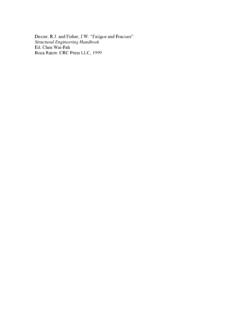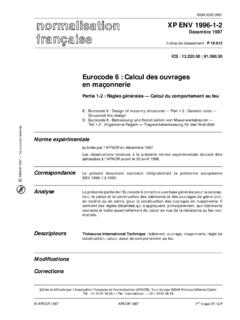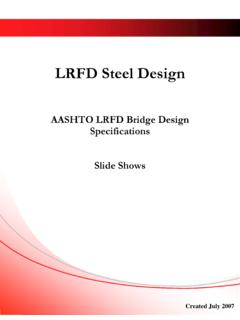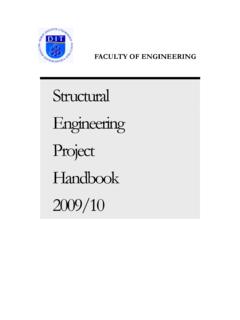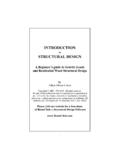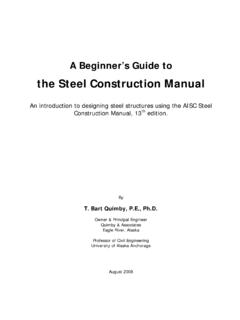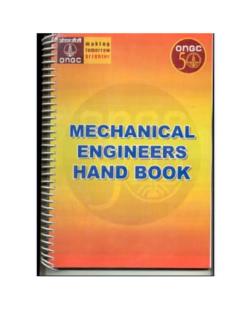Transcription of Structural Concrete Design - Free
1 Grider, A.; Ramirez, and Yun, Structural Concrete Design Structural engineering HandbookEd. Chen Wai-FahBoca Raton: CRC Press LLC, ,PurdueUniversity,WestLafayette,INYoungM ookYunDepartmentofCivilEngineering,Natio nalUniversity,Taegu, PropertiesofConcreteandReinforcingSteelP ropertiesofConcrete LightweightConcrete HeavyweightConcrete High-Strengt hConcrete ProportioningandMixingConcreteProportion ingConcreteMix Admixtures FlexuralDesignofBeamsandOne-WaySlabsRein forcedConcreteSt rengthDesign PrestressedConcreteStrengt ColumnsunderBendingandAxialLoadShortColu mnsunderMinimumEccentricity ShortColumnsunderAxialLoadandBending SlendernessEffects ShearandTorsionReinforcedConcreteBeamsan dOne-WaySlabsStrengthDesign PrestressedConcreteBeamsandOne-WaySlabsS trengt DevelopmentofReinforcementDevelopmentofB ar sinTension DevelopmentofBarsinCompression DevelopmentofHooksinTension Splices,BundledBars.
2 Two-WaySystemsDefinition DesignProcedu res MinimumSlabThicknessandReinforcement Direc tDesignMethod EquivalentFram eMethod FramesAnalysisofFrames gs DesignConsiderations Wal lFootings Sin gle-ColumnSprea dFootings CombinedFootings Two-ColumnFootings Strip,Grid,andMatFoundations sPanel,Curtain,andBearingWalls BasementWalls PartitionWalls rencesFurtherReading1 Thematerialinthischapterwaspreviouslypub lishedbyCRCP ressinTheCivilEngineeringHandbook, ,Ed., 1999byCRCP ressLLCAt this point in the history of development of reinforced and prestressedconcreteit is neces-sary to reexamine the fundamental approaches to Design of these composite materials. Structuralengineering is a worldwide industry. Designers from one nation or a continent are faced with de-signing a project in another nation or continent.
3 The decades of efforts dedicated to harmonizingconcrete Design approaches worldwide have resulted in some successes but in large part have ledto further differences and numerous different Design procedures. It is this abundance of differentdesign approaches, techniques, and code regulations that justifies and calls for the need for a unifi-cation of Design approaches throughout the entire range ofstructural Concrete ,from plain to fullyprestressed [5].The effort must begin at all levels: university courses, textbooks, handbooks, and standards ofpractice. Students and practitioners must be encouraged to think of a single continuum of structuralconcrete. Based on this premise, this chapter on Concrete Design is organized to promote suchunification. In addition, effort will be directed at dispelling the present unjustified preoccupationwith complex analysis procedures and often highly empirical and incomplete sectional mechanicsapproachesthattendtobothdistrac tthedesignersfromfundamentalbehaviorandi mpartafalsesenseof accuracy to beginning designers.
4 Instead, designers will be directed to give careful considerationto overall structure behavior, remarking the adequate flow of forces throughout the entire Properties of Concrete and Reinforcing SteelThe designer needs to be knowledgeable about the properties of Concrete , reinforcing steel, andprestressing part of the chapter summarizes the material properties of particular impor-tance to the Properties of ConcreteWorkabilityis the ease with which the ingredients can be mixed and the resulting mix handled, trans-ported, and placed with little loss in homogeneity. Unfortunately, workability cannot be measureddirectly. Engineers therefore try to measure the consistency of the Concrete by performing slump test is useful in detecting variations in the uniformity of a mix.
5 In the slump test, a moldshaped as the frustum of a cone, 12 in. (305 mm) high with an 8 in. (203 mm) diameter base and 4 in.(102 mm) diameter top, is filled with Concrete (ASTM Specification C143). Immediately after filling,the mold is removed and the change in height of the specimen is measured. The change in height ofthe specimen is taken as the slump when the test is done according to the ASTM , retainingitsoriginalshape. Apoormixcrumbles,segregates, and falls apart. The slump may be increased by adding water, increasing the percentage offines (cement or aggregate), entraining air, or by using an admixture that reduces water requirements;however, these changes may adversely affect other properties of the Concrete . In general, the slumpspecified should yield the desired consistency with the least amount of water and should withstand the weathering, chemical action, and wear to which it will be subjectedin service over a period of years; thus,durabilityis an important property of Concrete .
6 Concreteresistance to freezing and thawing damage can be improved by increasing the watertightness, en-training 2 to 6% air, using an air-entraining agent, or applying a protective coating to the agents damage or disintegrate Concrete ; therefore, Concrete should be protected with aresistant coating. Resistance to wear can be obtained by use of a high-strength, dense Concrete madewith hard 1999 by CRC Press LLCE xcess water leaves voids and cavities after evaporation, and water can penetrate or pass throughthe Concrete if the voids are interconnected. Watertightness can be improved by entraining air orreducing water in the mix, or it can be prolonged through change of Concrete should be considered, since expansion of the Concrete may causebuckling and drying shrinkage may cause cracking.
7 Expansion due to alkali-aggregate reaction canbe avoided by using nonreactive aggregates. If reactive aggregates must be used, expansion maybe reduced by adding pozzolanic material ( , fly ash) to the mix. Expansion caused by heat ofhydration of the cement can be reduced by keeping cement content as low as possible; using Type IVcement; and chilling the aggregates, water, and Concrete in the forms. Expansion from temperatureincreases can be reduced by using coarse aggregate with a lower coefficient of thermal shrinkage can be reduced by using less water in the mix, using less cement, or allowingadequate moist curing. The addition of pozzolans, unless allowing a reduction in water, will increasedrying shrinkage. Whether volume change causes damage usually depends on the restraint present;consideration should be given to eliminating restraints or resisting the stresses they may cause [8].
8 Strength of Concrete is usually considered its most important property. Thecompressive strengthat 28 d is often used as a measure of strength because the strength of Concrete usually increaseswith time. The compressive strength of Concrete is determined by testing specimens in the formofstandard cylindersas specified in ASTM Specification C192 for research testing or C31 for fieldtesting. The test procedure is given in ASTM C39. If drilled cores are used, ASTM C42 should suitability of a mix is often desired before the results of the 28-d test are available. A formulaproposed by W. A. Slater estimates the 28-d compressive strength of Concrete from its 7-d strength:S28DS7C30pS7( )whereS28D28-d compressive strength, psiS7D7-d compressive strength, psiStrength can be increased by decreasingwater-cement ratio,using higher strength aggregate, usinga pozzolan such as fly ash, grading the aggregates to produce a smaller percentage of voids in theconcrete, moist curing the Concrete after it has set, and vibrating the Concrete in the forms.
9 Theshort-time strength can be increased by using Type III portland cement, accelerating admixtures,and by increasing the curing stress-strain curve for Concrete is a curved line. Maximum stress is reached at a strain of , after which the curve of elasticity,Ec, as given in ACI 318-89 (Revised 92),Building Code Requirementsfor Reinforced Concrete [1], is:EcDw1:5c33pf0clb/ft3and psi( )EcDw1:5c0:043pf0ckg/m3and MPa( )wherewcDunit weight of concretef0cDcompressive strength at 28 dTensile strength of Concrete is much lower than the compressive strength about 7pf0cfor thehigher-strength concretes and 10pf0cfor the lower-strength is the increase in strain with time under a constant load. Creep increases with increasingwater-cement ratio and decreases with an increase in relative humidity.
10 Creep is accounted for indesign by using a reduced modulus of elasticity of the 1999 by CRC Press ConcreteStructural lightweight Concrete is usually made from aggregates conforming to ASTM C330 that areusually produced in a kiln, such as expanded clays and shales. Structural lightweight Concrete has adensity between 90 and 120 lb/ft3(1440 to 1920 kg/m3).Production of lightweight Concrete is more difficult than normal-weight Concrete because theaggregates vary in absorption of water, specific gravity, moisture content, and amount of grading ofundersize. Slump and unit weight tests should be performed often to ensure uniformity of the placing and finishing of the Concrete , the aggregates may float to the surface. Workabilitycan be improved by increasing the percentage of fines or by using an air-entraining admixture toincorporate 4 to 6% air.
